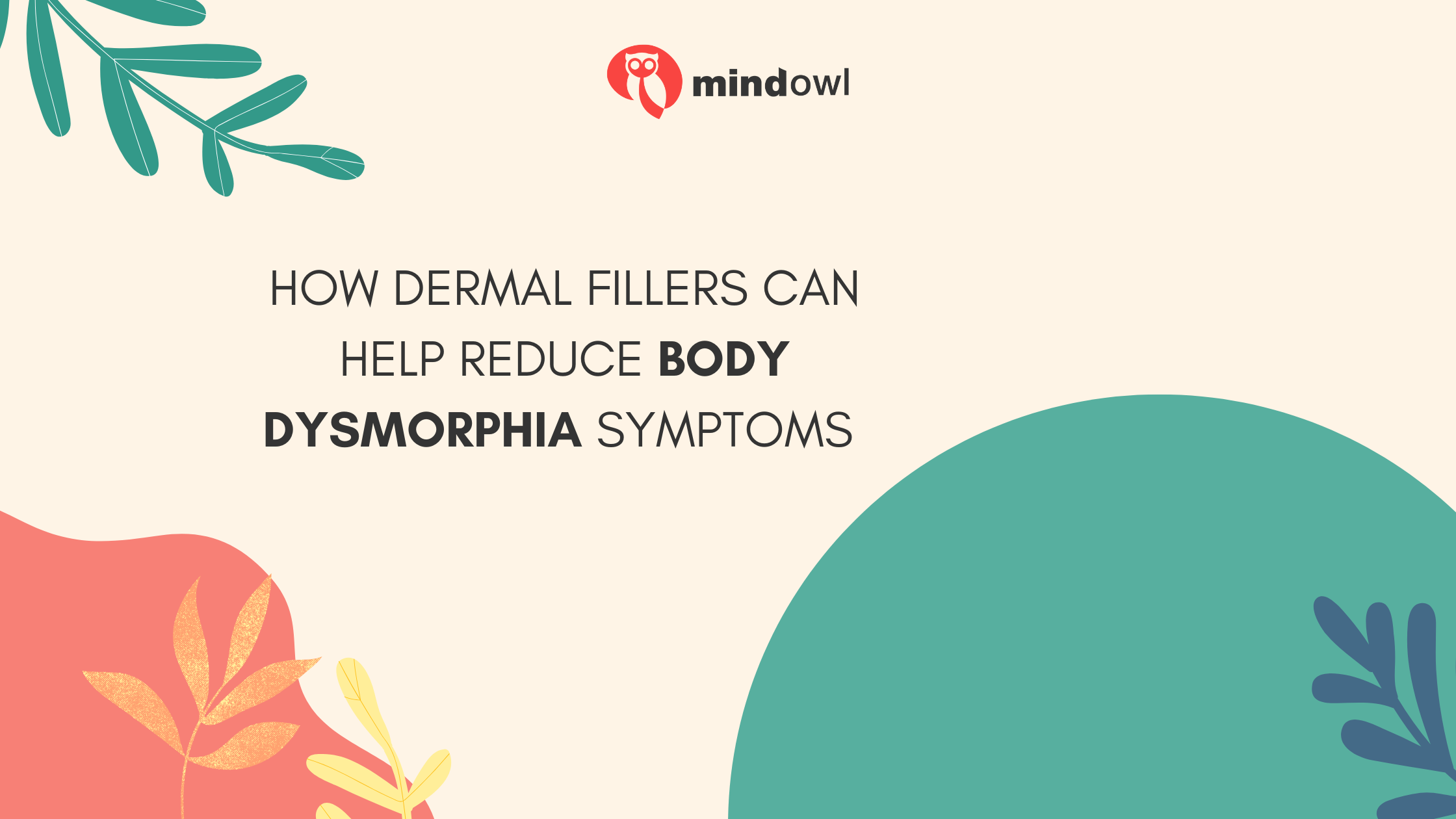Many people worry about how they look because of body dysmorphic disorder. Dermal fillers are a noninvasive procedure that can help with this issue. This article will show how these treatments might improve self-esteem and reduce symptoms.
Keep reading to learn more.
Quick Facts
- Body dysmorphia makes people stress about their looks, seeing flaws that aren’t there. Dermal fillers can improve how they feel about themselves by tackling specific concerns.
- While dermal fillers offer a quick fix to boost self-esteem, it’s important to know the risks. They might not solve deeper issues of body image and could lead to filler dysmorphia if expectations are unrealistic.
- Experts suggest consulting with licensed professionals and setting realistic goals before getting treatments. This approach helps avoid dissatisfaction and promotes a healthier body image.
- Filler dysmorphia happens when someone keeps focusing on minor imperfections even after cosmetic procedures. Recognizing signs early and seeking mental health advice can prevent it.
- Proper treatment involves both certified cosmetic experts who understand body image issues and therapy like cognitive-behavioral therapy to improve self-esteem and tackle underlying problems effectively.

Understanding Body Dysmorphia
Body dysmorphia affects how individuals see themselves. This mental health issue can stem from various factors, including genetics and societal pressures.
Definition of body dysmorphia
Body dysmorphia is a mental health condition. It causes people to obsess over their appearance. Individuals with this disorder often see flaws in themselves that others do not notice.
They may focus on specific body parts, such as skin, hair, or weight.
This condition can lead to severe emotional distress and low self-esteem. Many who suffer from body dysmorphia seek cosmetic treatments to address these perceived concerns. However, these procedures might not always help improve their psychological wellbeing.
Understanding body image perception is crucial in addressing the symptoms of body dysmorphia effectively.
Causes of body dysmorphia
Body dysmorphia often arises from various factors. Genetics plays a significant role. Studies show that individuals with a family history of mental health issues are more likely to develop this condition.
Environmental influences also contribute to body image concerns. Social media and unrealistic beauty standards can distort self-image. Negative experiences, such as bullying or trauma, may trigger symptoms as well.
These elements create a cycle of dissatisfaction with one’s appearance. Many sufferers focus on perceived flaws rather than their overall qualities. Such obsessive thoughts can lead individuals to seek cosmetic procedures like injectable fillers and plastic surgery in hopes of improving their self-esteem and emotional wellbeing.
Understanding these causes highlights the importance of addressing underlying mental health issues before pursuing cosmetic treatments.
Impact of Cosmetic Treatments on Body Dysmorphia
Cosmetic treatments can lead to both positive and negative effects on people with body dysmorphia. While some may seek these procedures for improvement, others might face risks that could worsen their symptoms.
Risks of cosmetic treatments for individuals with body dysmorphia
Cosmetic treatments can pose significant risks for individuals with body dysmorphia. Many people seek these procedures to fix perceived flaws. They often believe that a dermal filler or botulinum toxin will solve their appearance concerns.
Yet, these treatments may not address the underlying issues of self-image and self-esteem. Individuals might undergo multiple procedures in pursuit of perfection, leading to dissatisfaction and increased anxiety.
Filler dysmorphia can develop as a result of this ongoing quest for improvement. It involves an obsessive focus on minor imperfections exacerbated by cosmetic interventions. Understanding the risks is crucial for anyone considering noninvasive cosmetic procedures.
It’s important to weigh these factors carefully before making any decisions regarding treatment options like fillers and botulinum toxin.
Reasons for seeking cosmetic treatments
Many people seek cosmetic treatments to improve their appearance and boost self-esteem. They often feel unhappy about specific features, such as dynamic facial lines or unwanted volume loss.
Noninvasive procedures like dermal fillers can offer quick solutions. These treatments allow individuals to see immediate changes without the risks of surgery.
Some choose cosmetic enhancements to feel more confident in social situations. Many clients hope that improving their self-image will change how they interact with others. For some, these adjustments act as a way to combat body dysmorphia symptoms.
Understanding this drive helps cosmetic practitioners provide better care for their patients’ needs.
How Dermal Fillers Can Help Reduce Body Dysmorphia Symptoms
Dermal fillers offer a non-invasive way to improve self-image. They can help individuals address their perceived flaws and boost their confidence.
Non-invasive alternative to surgical procedures
Non-invasive treatments, like dermal fillers, offer a simpler option for those seeking cosmetic enhancements. These fillers improve self-image without the need for surgery. Patients can see immediate results with minimal downtime.
This appeals to many individuals who feel anxious about more invasive procedures.
Many choose non-surgical options to tackle perceived flaws safely and effectively. By using dermal fillers, they boost self-esteem while avoiding surgical plastic surgery complications.
Among the leading dermal fillers available, Juvederm stands out as a trusted choice. Known for its smooth consistency and natural-looking results, Juvederm is specifically formulated to address various aesthetic concerns, from smoothing fine lines to restoring lost volume. Its wide range of products caters to different needs, making it an excellent option for individuals seeking tailored solutions to their appearance concerns.
This approach not only addresses their concerns but also supports a positive body image in a less intimidating way.

Addressing perceived concerns
Dermal fillers provide a way to address perceived concerns about one’s appearance. Many individuals feel dissatisfied with their self-image. They often seek these treatments to improve how they look without undergoing surgery.
Fillers can enhance facial features, making people feel more confident.
First-hand experience shows that addressing specific worries can boost self-esteem significantly. For example, someone may focus on volume loss in their cheeks or the appearance of fine lines.
Filler injections can create a fuller, rejuvenated look and help alleviate those concerns effectively. People leave feeling happier with their reflection in the mirror, leading to improved overall well-being.
Boosting self-esteem
Cosmetic procedures can significantly boost self-esteem. Many people seek treatment to enhance their appearance and improve self-image. With dermal fillers, individuals often see immediate improvements.
This non-surgical option addresses perceived flaws without the risks of surgery. First-hand experience shows that these enhancements lead to increased confidence in social situations.
Feeling good about one’s appearance can have a powerful effect on overall well-being. Improved self-esteem empowers individuals to engage more fully with life. Clients frequently express satisfaction after seeing positive changes from their treatments.
These boosts help them feel better about themselves every day.
Experts’ Insights on Filler Dysmorphia
Filler dysmorphia represents a growing concern in cosmetic procedures. Experts warn that individuals may develop unrealistic expectations from fillers, leading to dissatisfaction and negative self-image.
What is filler dysmorphia?
Filler dysmorphia occurs when individuals become fixated on their looks after receiving dermal fillers. They often perceive their appearance as inadequate, despite changes made by the procedure.
This condition can lead to excessive dissatisfaction with self-image and increased anxiety about cosmetic enhancements.
People may seek more filler injections in hopes of improving their self-esteem, but this approach can create a harmful cycle. Filler dysmorphia reflects a deeper issue related to body image.
Awareness of this condition is crucial for those considering nonsurgical cosmetic procedures like dermal fillers.
Reasons for developing filler dysmorphia
People often develop filler dysmorphia due to unrealistic standards of beauty. Social media plays a significant role in shaping these perceptions. Constant exposure to filtered images can distort one’s self-image.
Many individuals compare themselves to influencers and celebrities. This creates pressure to achieve similar looks.
Filler dysmorphia can also arise from psychological issues. Those struggling with low self-esteem may seek out fillers as a solution. They believe that enhancing their appearance will alleviate feelings of inadequacy.
First-hand experience shows that the cycle can be harmful, leading to further dissatisfaction despite treatment efforts.
Symptoms of filler dysmorphia
Filler dysmorphia can lead to several noticeable symptoms. Individuals may obsess over their appearance, particularly the areas treated with fillers. They often feel dissatisfied despite achieving results that many would consider positive.
People may also seek frequent touch-ups to fix issues that are mainly in their minds. Some experience anxiety and depression about their looks, which can harm self-esteem. Increased social isolation might occur as they avoid situations where others could see them.
Prevention and Treatment of Filler Dysmorphia
To prevent filler dysmorphia, individuals should consult licensed professionals and prioritize realistic expectations. Seeking guidance from mental health experts can also assist in addressing underlying concerns.
Read more to discover effective strategies for maintaining a healthy relationship with cosmetic treatments.
How to avoid developing filler dysmorphia
Recognize the signs of filler dysmorphia early. Stay aware of how your self-image fluctuates after cosmetic treatments. Choose professionals who focus on enhancing natural beauty rather than promoting extreme changes.
Consult with a mental health expert if you feel anxious about appearance or rely too heavily on filler enhancements to boost self-esteem.
Engage in open conversations with trusted friends and family about your feelings towards body image. Seek support from others who understand these issues. Their insights can help ground your perspective and promote a healthier self-image.
Prioritizing emotional well-being is key to avoiding negative impacts from cosmetic procedures.
Seeking proper treatment
Proper treatment for filler dysmorphia involves finding qualified professionals. Choose experts who understand both cosmetic procedures and mental health. Look for practitioners with certifications and experience in managing body image issues.
Therapy can also play a crucial role. Cognitive-behavioral therapy helps individuals address their concerns about self-image. It assists them in building healthy habits and improving self-esteem.
Supportive environments encourage open discussions about feelings related to appearance, fostering better outcomes. Seeking proper treatment is essential for promoting overall well-being and addressing the symptoms of body dysmorphia effectively.
Conclusion
Dermal fillers offer a non-invasive way to improve self-image. They can address specific concerns that affect one’s appearance. Many people find that these treatments boost their confidence and self-esteem.
However, it is crucial to approach cosmetic enhancements thoughtfully. Careful consideration helps prevent potential issues like filler dysmorphia.
FAQs
1. What is the link between dermal fillers and self-esteem?
Dermal fillers can enhance physical features, which may boost self-esteem in individuals struggling with body dysmorphia.
2. How do dermal fillers affect one’s self-image?
By altering physical attributes that a person may be insecure about, dermal fillers can positively impact a person’s self-image.
3. Can using dermal fillers reduce symptoms of body dysmorphia?
While not a cure, some people experience reduced symptoms of body dysmorphia after receiving dermal filler treatments due to improved self-esteem and enhanced self-image.
4. Are there any risks associated with using dermal fillers to combat body dysmorphia?
MindOwl Founder – My own struggles in life have led me to this path of understanding the human condition. I graduated with a bachelor’s degree in philosophy before completing a master’s degree in psychology at Regent’s University London. I then completed a postgraduate diploma in philosophical counselling before being trained in ACT (Acceptance and commitment therapy).
I’ve spent the last eight years studying the encounter of meditative practices with modern psychology.

